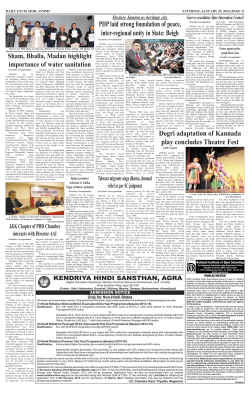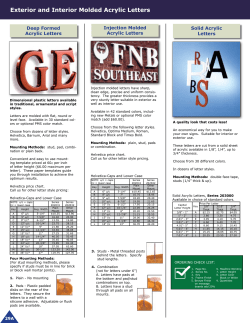
Hkwxksy fpUru General Landuse Pattern in Jammu District of J&K: A Geographical Analysis
Hkwxksy International Refereed ^fpUru* fjlpZ tuZy o"kZ 2] vad 2 (ISSN : 2229-7227) (i`-la- 303-308) foØeh lEor~ % pS=&T;s"B 2069 ¼vizSy&twu] 2012½ General Landuse Pattern in Jammu District of J&K: A Geographical Analysis Dr. Shashi Prabha Assistant Professor P.G. Department of Geography University of Jammu, Jammu Abstract Landuse of a region is a combined result of the natural setup and human dynamism within socio-economic setup and technological development. Physical limitation of the site finds a direct expression in landuse. Landuse pattern is studied to understand the geographical adjustment of agriculture resources. Landuse in special content is essential to understand regional zonation of the areas of optimum landuse degraded areas etc. The use of land constitutes a major item in national and regional planning in India. This study of landuse is of vital importance from the point of view of the planning and development of the thre herrogeneous belts of the district namely kandi, semi kandi and plain. Key-Words : Landuse, Agricultural Region, Irrigated land Cultivation. INTRODUCTION Man plays a pivotal role in conditioning and transforming his physical environment through its utilization. The two sets of limits which determine the pattern of landuse are the absolute or outer limits which are set by nature and relative limits set by cultural, human attitudes and actions which determine the range of actual and probable use within limits which classifying land under different heads its subsequent use by man for a particular purpose is taken into consideration. An analysis of rural land use becomes relatively more significant in the geographical study of a predominantly rural and overwhelmingly agricultural region. An analysis of spatial and temporal changes in rural land-use components can help in explaining the spatial disharmonies in distribution and growth, in understanding the socio-geographical environment, and in estimating the development potentialities in agriculture and related activities. Land-use components, such as the area not available for cultivation, cultivable waste and net sown area as well as irrigated and double cropped area, have a tendency to 303 ^fpUru* =Sekfld fjlpZ tuZy • vizy S µtwu 2012 show spatial and structural changes in response to variations in physio-economic and spatio cultural factors and the process of rural development. In a tradition bound, small-scale subsistence agriculture, area not available for cultivation remains high because of several physical factors, and gradually declines with increasing population and developing agriculture but rises again with the development of physical infrastructure, social overheads and other agriculture based non-farm activities, services and institutions. Cultivable waste is influenced by the rural population pressure, marginal productivity and ecological awareness, level of technology as well as land and water management practices. Net area sown may decline during the process of agricultural and rural development. Expansion in double cropped area with an increase in irrigational facilities will ensure a large total cultivated area. Simultaneously, efficient land management and agricultural operations will result in a large farm output and a higher level of rural income. As per the heterogeneous nature of the study area the selected samples for the study have been collected from the three varied physiographic belts namely kandi, semi kandi and plain. The data related to the different components of the land use have been collected from the census records, District hand book and through personal survey of the sample villages. OBJECTIVES · To categorized general landuse over the three diversified physiographic zones in the study area. · To study the general landuse change over the kandi, semi kandi and plain belt of Jammu district. · To find out scope for extention of cultivation area infuture. STUDY AREA The District Jammu is situated in the southern part of the J&K State. It lies between 32°-37’N to 33°-05’ North latitude and 74°-19’ East, 75°-20’ East of longitude. The district extends over an area of 3097 sq. km. The district consists ^fpUru* =Sekfld fjlpZ tuZy • vizSyµtwu 2012 304 of four tehsils (i) Jammu, (ii) Akhnoor, (iii) R.S. Pura and (iv) Bishnah. The district on the north and north east in surrounded by Udhampur district, on its east lies Samba district. In the west its boundaries touch the Rajouri district while ion its south and south east it shares territorial limits with Pakistan. The line of actual control exists to separate area of Chammb from the Pakistan occupied parts of the States of J&K. The location of Jammu district is therefore, strategically very significant. METHODOLOGY The present study has been done on the data generated from the field study. Fifty sample villages covering the heterogeneous terrain of Jammu district has been selected and the proportional allocation method was used to obtain the different sample sizes from the different blocks of the study region. EXPLANATION The investigation of the study have been recorded over the different landuse components which are explained in the following lines: Size of Cultivable land: The table 1 reveals that there are perceptible variations with respect to the size of cultivable land. The plain belt of the study area has recorded the highest percentage of area under this category (51.4%). It has been followed by the semi kandi belt which has registered 4866.09 hectare of area which account for 37.7% to the total area. The kandi belt of the district has the lowest share of cultivable land it has 1027.53 ha of area which contribute 10.8% to the total area in the study region Table 1. Size of Uncultivable Land About 2.3 ha of land under this category has been recorded in the semi kandi belt which account for 5.4% of area in the study region. The plain belt has shown a highest trend in the percentage share of uncultivable land which has recorded 39.65 ha which comprises 94.5% of land in the study region. Area Under Forest No share of land has been registered under this category in the plain belt. The plain surface and good quality of soil in the plain area has put all the available area under use and no share of land in the plain belt has been recorded under forest cover. However, at the same time the kandi and semi kandi belts of the study area has shown the highest composition of area under forest. Here, the semi kandi belt has recorded the maximum share of forest, which has 71.5% to the total area. Similarly, the kandi belt has also constituted 28.4% of area under the forest cover in the study area. The rugged and dissected terrain has resulted, the growth of thorny bushes and trees in these belts table 1. Area not available for cultivation Area under this landuse component has not shown the significant spatial variations. All the three categories under the study have recorded more or less the similar composition of area with least variations. The table 1 reveals that the kandi belt has 32%, semi kandi has 33% and the plain belt has the maximum of 34.6% of area not available for cultivation. The significant share of area under 305 ^fpUru* =Sekfld fjlpZ tuZy • vizy S µtwu 2012 this component is resulted because of the human settlements and the building of physical infrastructure in the study area. Size of Fellow Land So far the spatial status of the fellow land is concerned, it has revealed from the analysis of the study that no share of land has been found in this category. However, the remaining two categories namely semi kandi and plain belts of the study area are also having the lowest percentage of fellow land in Jammu district. Table 1. Size of Waste Land This component indicates the potential for further expansion in the cultivated area. It has been recorded that the kandi and semi kandi belts of the study area has some percentage of area under this category which can be brought under the cultivation. The plain belt of the district has registered no share of land in this category. Size of Irrigated Land A remarkable spatial variation in the size of irrigated area has been seen in the study region. The kandi belt of the district has the lowest proportion of irrigated area by recording 96.84 ha of area to the total irrigated area in the region. It has been followed by the semi kandi belt which has 947.96 hectare of irrigated area out of 5257.8 hectare which stands at 18% to the total irrigated area. The well established canal network and other private source of water for crops has put the plain belt at the highest which has more than 80% of irrigated area. It has 4213.0 ha of area out of the total 5257.8 ha of irrigated area in the study region. Table 1: Salient Characteristics of General Landuse Patterns Jammu District 2010-11. ^fpUru* =Sekfld fjlpZ tuZy • vizSyµtwu 2012 306
© Copyright 2025














